[The six-page exhibition handout proclaims “Photography is encouraged,” and all the images accompanying the review below were taken on my iPhone. Click on images to enlarge them.]
The Life Room



Left: The curved railing separating the students in the life drawing class from the model and instructor. The lower railing, which has traces of old paint, provides a place to rest one's drawing pad, panel, or canvas. Middle: The light reflector, which at first must have held candles, then later gas lights, and finally electric bulbs, moved on a curved track that permitted the instructor to cast different shades on the model. Right: The grisly plaster cast made from a flayed corpse to demonstrate the anatomy of a crucified man.
The most obvious appeal of Pilkington’s “site-specific installation” (3) for readers of the Victorian Web lies in the opportunity it provides to experience a room used for life drawing — perhaps the very room — in which Hunt, Millais, and hundreds of other nineteenth-century artists spent so many hours. It helpfully contains some 21 plaster casts that students had to copy before proceeding to life drawing, and these include the expected busts of Homer, Asclepius, and Antinous as Bacchus as well as casts after works by Michelangelo and Donatello. One also sees the four casts of écorchés — full or partial figures flayed to show students anatomical details, the most grisly of which is the cast made from the corpse of the executed criminal James Legg.
Setting her installation in this room packed with so many powerful, if not always perceived, historical associations, Pilkington obviously places her eleven titled works and fragments of many others in a informational space, that has the potential to permit her to claim that her “dolls” function teleologically as the culmination of all those hundreds of hours spent by others in the Life Drawing Room. Of course, she could also use her work to critique, mock, or even deny the importance of this no-longer used space. Certainly, as the first paragraph in the introduction to the handout suggests, the Life Room exists as a monument to a skill no longer needed, to an art obsolete and in the way of that now being praticed: “Almost unchanged since the eighteenth century, the Life Room of the Royal Academy Schools is a living relic of traditional art education. Since RA Schools was fashioned into a contemporary school of arts in 1998, the activity of the room has shifted; drawing from antique casts and live models is no longer a core activity and has largely been replaced by lectures and seminars" (emphasis added). The old instructional practice that followed the Ruskinian notion that one learns to see by attempting to draw, that to a large extent one sees with one's hands, "is no longer a core activity.” Instead, talking about how things look or listening to others tell students how they look has replaced the difficult struggle to draw, but, we are told, there's no need to worry: “theory has joined figuration,” and the room's "role within the RA schools has become one of intellectual debate as well as material learning.”
The Life Room Transformed

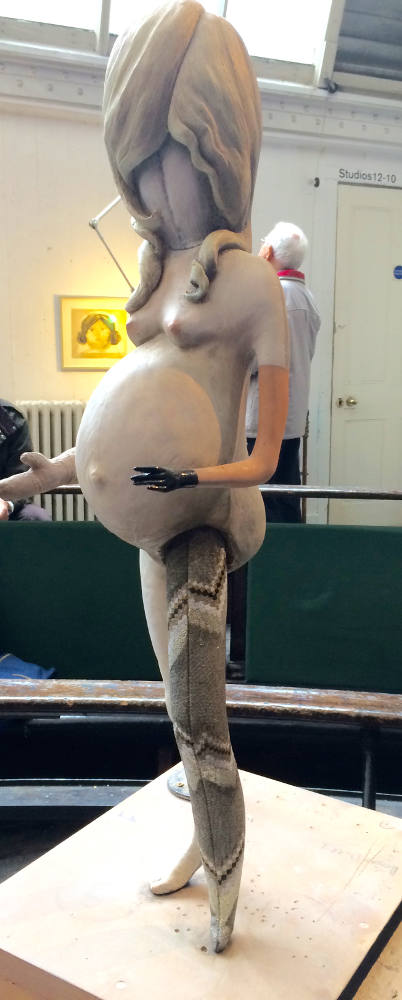
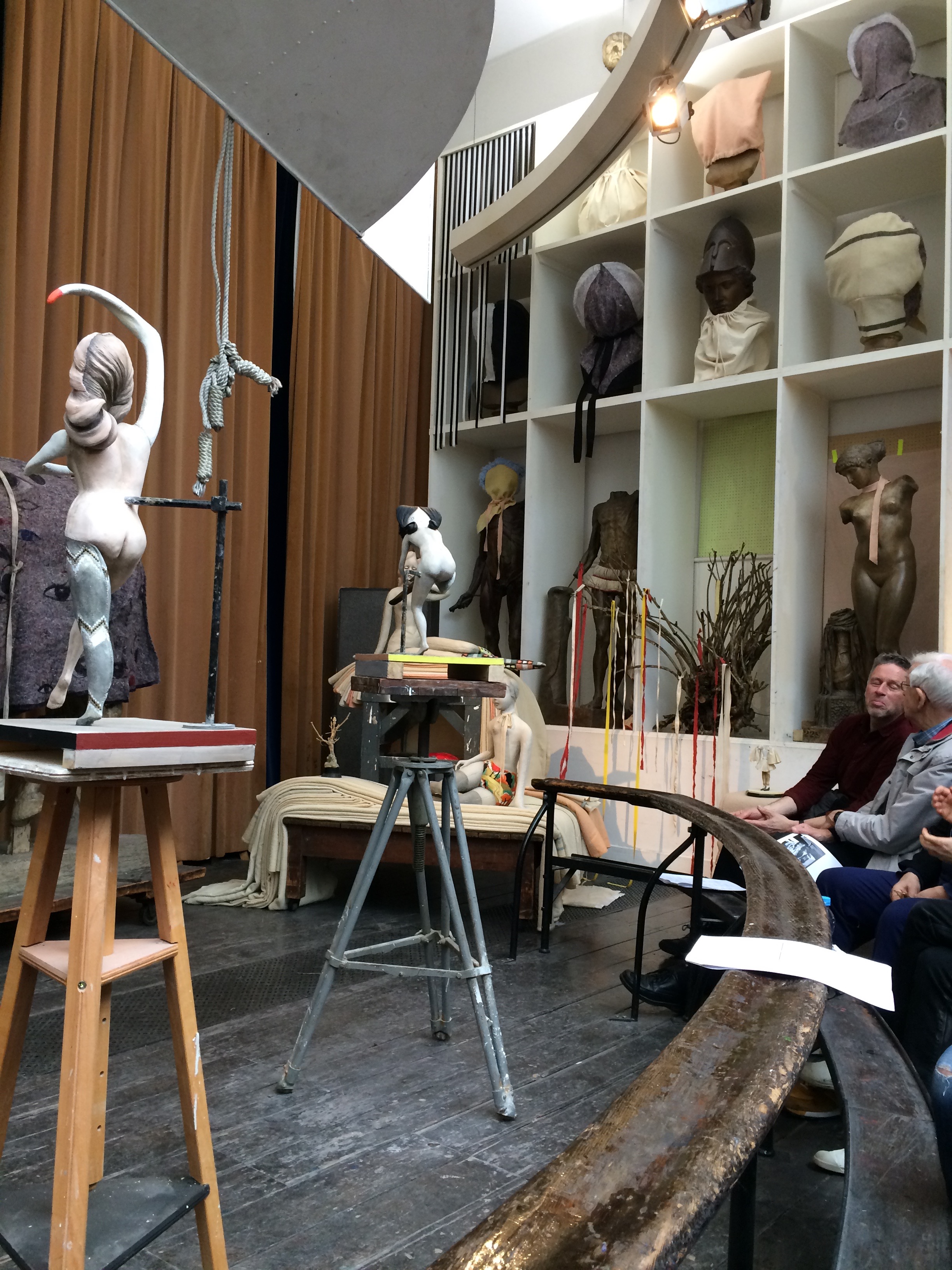
Three photographs of the dolls in the context of the older casts.
“Cathie Pilkington RA’s site-specific installation,” we read in the handout and were told by the student guide, “cast[s] a critical eye at the sculptural tradition and its use of the female figure. Dressing the antique sculpture in feminine adornments subverts their heroic status, bringing them in line with the intimate, domestic register of Pilkington’s dolls, dummies and ornaments. The articulate RA student guide emphasized the installation’s critique of the way artists have objectified women. There's nothing particularly novel, much less outrageous, in the by-now mainstream criticism of the way visual representation from painting and sculpture to rap videos, from advertising to fashion, has treated and continues to treat women as objects.
Unfortunately, the problem with a site-specific installation, particularly when the site possesses obvious, strong associations, lies in the power that historical objects have to talk back to the recent artworks that supposedly criticize or satirize one. In the first place, since we are encountering ghosts, there's the somewhat troublesome fact that both women and men modeled nude, and one can make the case that this practice was more demeaning to the male models, RA porters pressed into service, that to the prostitutes who in modeling certainly had a much safer way of earning money than on the very dangerous streets. Second, the cast of the flayed corpse of John Legg — an all too literal objectification of a human being — certainly distracts from the more abstract objectification of women. Why didn't Pilkington, who covered so many sculptural objects, including the écorché horse (why?), just keep the crucifixion out of view? The way the grisly crucifixion intrudes upon the rest of the installation is one of several points at which the artist seems more than a little tone deaf, oblivious to the variety of meanings and implications that the site has. Another problem arises in “dressing” the casts of ancient sculpture, which supposedly “subverts their heroic stature.” Even if one assumes that all the covered heads are heroic, covering them, not letting the viewers see them at all, strikes me as censorship more than commentary. If Pilkington, say, covered parts of the Parthenon fragment with doll’s clothes, that might have made the point.
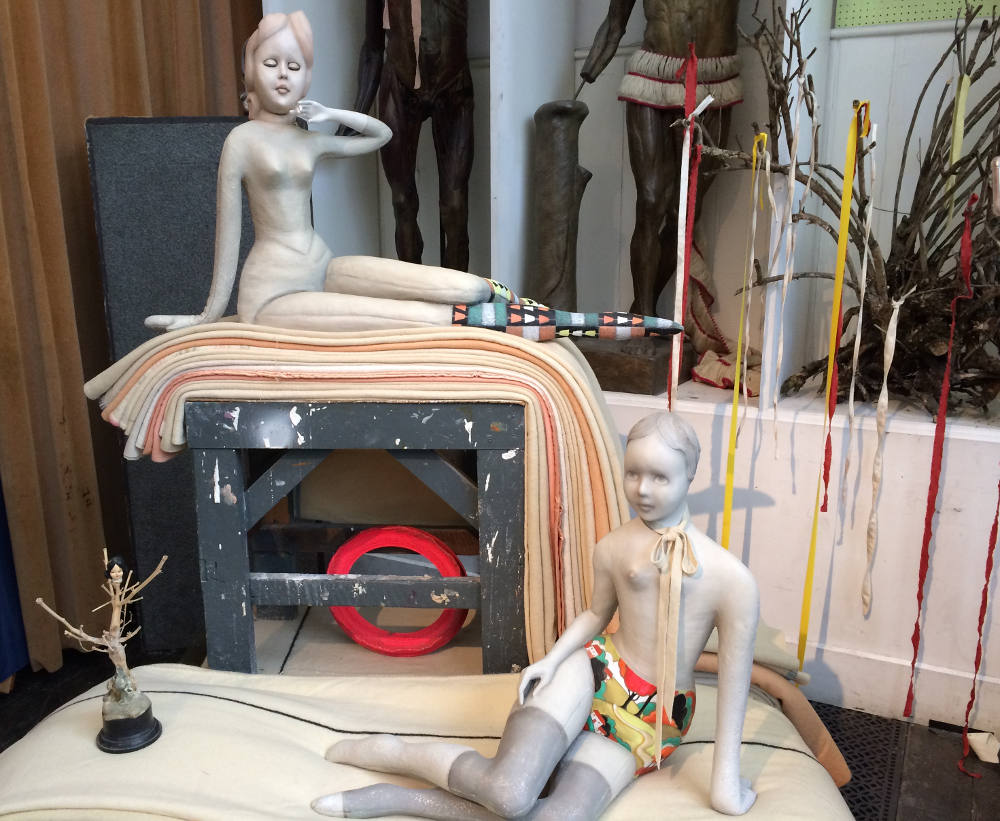

Left: Two somewhat more conventional figures that several viewers commented looked like the dress dummies found in store windows. Right: The broken, seated dummy.
The dolls themselves of course take center stage, the majority of them having one more-or-less anatomically correct leg with another looking like a transplanted snake or eel. Where faces might be expect to appear, we find buttocks, and facial features appear on the rear of the figure's head. The broken seated figure (above) and the many fragments of body and non-body parts (below) speak to the effort that the artist has expended as do the many preparatory drawings displayed on the walls, which also serve to make clear that the jointless arms on some of the figures that appear to be little more than pulled out and bent bits of clay are in fact intentional.
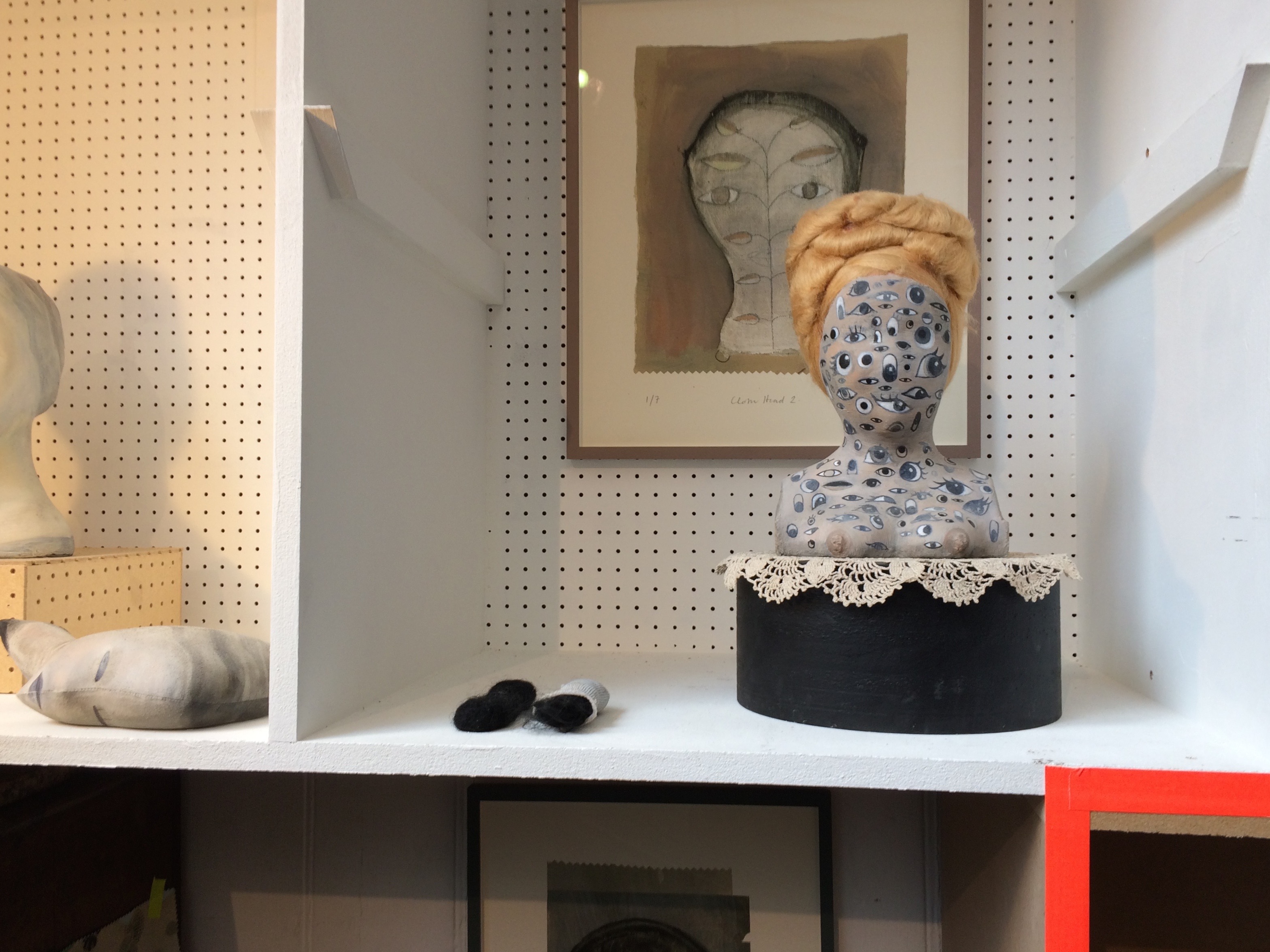
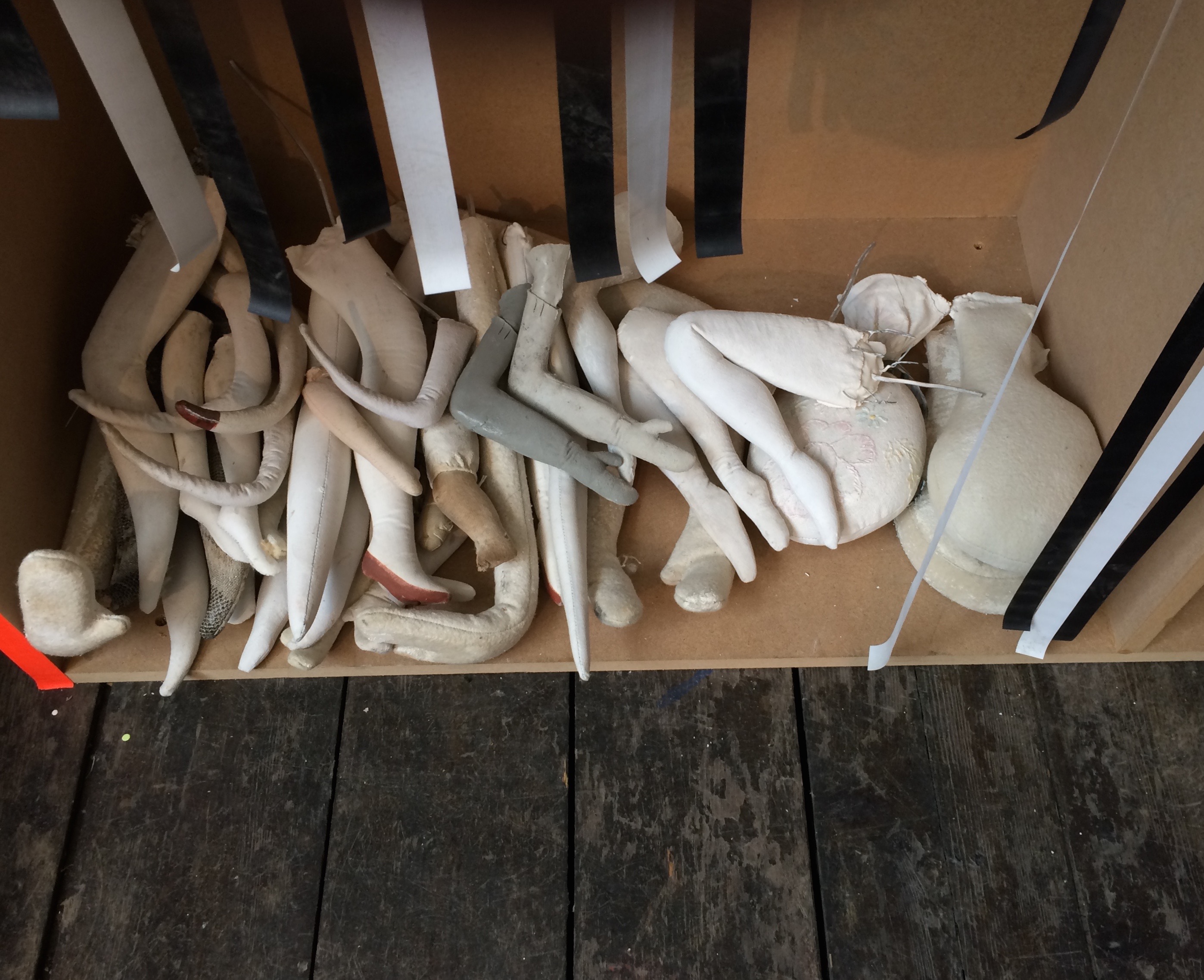
Since the artist calls her works “dolls” and “dummies,” she would seem to remove them from competition or comparison with traditionsal figurative sculpture. Her work seems to relate more to what today is the most widespread and commercially viable form of popular representations of human and humanoid forms — those aggressively low culture, exiled art forms comprising action figures, high-end dolls, and carefully sculpted polychrome representations of characters from science-fiction cinema, manga, anime, video games, and graphic novels, the kinds of figures sold, often for hefty prices, at Comic Con and other similar conventions, where attendees make themselves doll-like, transforming themselves into imaginary characters, many of whom have distorted or amplified bodies. Be that as it may, Pilkington RA has created her dolls and then placed them in an interesting pop-up, two-week exhibition that provided its visitors with plenty of food for thought.
Bibliography
Pilkington, Cathie. Anatomy of a Doll: A Project” by Cathie Pilkington RA. Exhibition catalogue. London: Royal Academy, 2017. 6 pp.
Last modified 17 April 2017